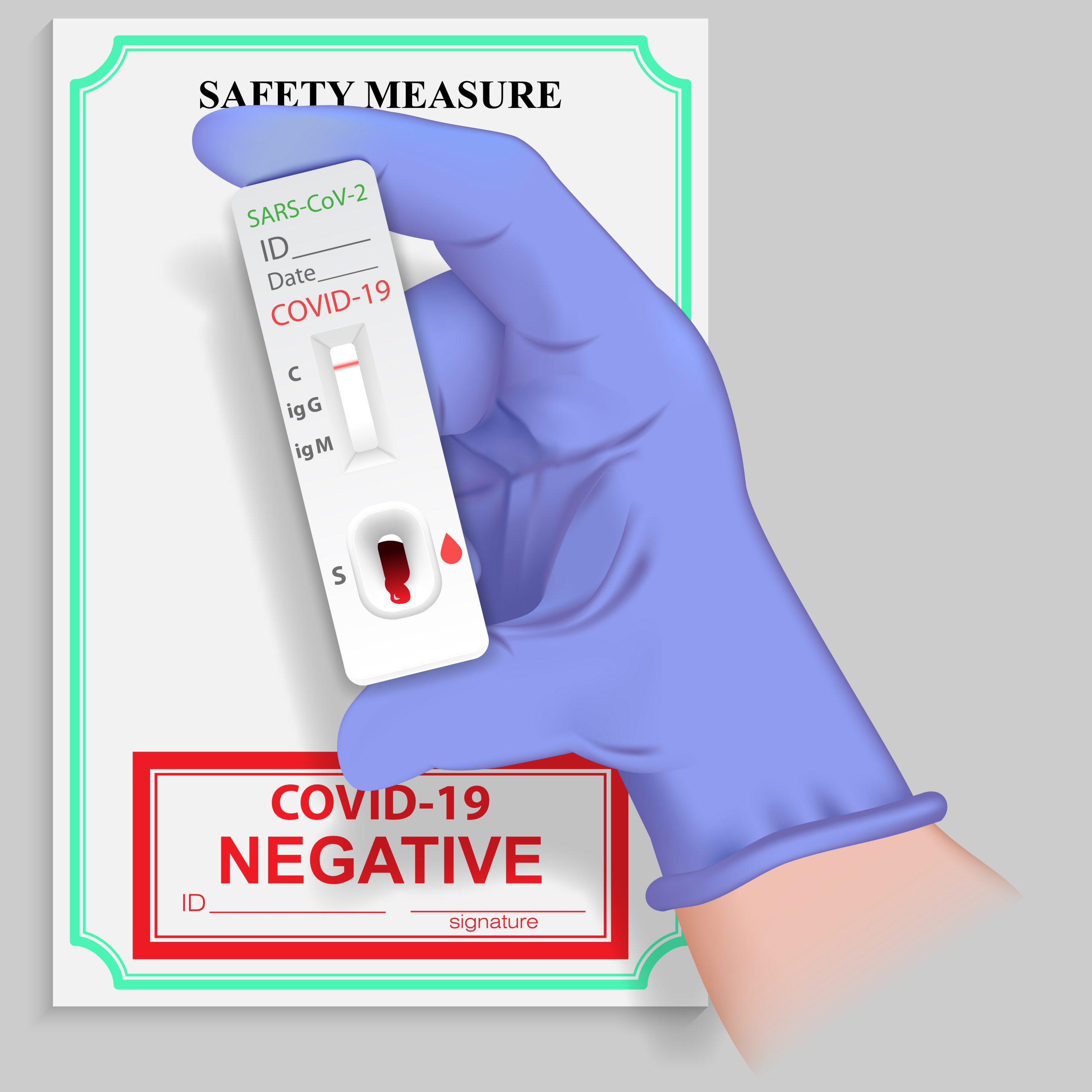“The benefits of more accurate diagnostics are arguably more impactful than the benefits of improved data tables in Enfish and computer animation in McRO. If the USPTO and the courts aim to be technology-agnostic, medical technology should not be treated differently than computer technology.”
 A strategy for the COVID-19 pandemic is testing for antibodies to determine possible immunity. Such diagnostic tests may suffer from a high false positive rate. Improving accuracy is therefore desirable. However, the U.S. Patent and Trademark Office (USPTO) is generally not receptive to diagnostic claims that improve accuracy. The recent case of CardioNet v. Infobionic, makes patenting more accurate diagnostics easier.
A strategy for the COVID-19 pandemic is testing for antibodies to determine possible immunity. Such diagnostic tests may suffer from a high false positive rate. Improving accuracy is therefore desirable. However, the U.S. Patent and Trademark Office (USPTO) is generally not receptive to diagnostic claims that improve accuracy. The recent case of CardioNet v. Infobionic, makes patenting more accurate diagnostics easier.
Test Claim
This article applies the case law with this simplified claim:
-
- A method of diagnosing COVID-19 immunity, comprising:
measuring analyte levels associated with coronavirus antibodies in blood sample(s),
determining a parameter from the analyte levels using technique X,
determining a diagnosis of COVID-19 immunity based on the parameter using technique Z; and
outputting the diagnosis.
Assume technique X and/or Z provides more accurate detection of COVID-19 immunity over existing techniques, which misidentify immunity attributable to other coronaviruses.
Eligibility by Improvement
Under Alice Corp. Pty. Ltd. v. CLS Bank Int’l, claims cannot be directed to a judicial exception (a law of nature, a natural phenomenon, or an abstract idea) without significantly more. Examiners may reject diagnostic claims as directed to an abstract idea or natural phenomenon. The identified abstract ideas in diagnostic claims may include mathematical concepts (i.e., mathematical formulas used to determine a parameter from analyte level(s)) and mental processes (i.e., comparing one measurement to a reference level). The natural phenomenon may relate to a correlation between an analyte level and a disease.
Even if the claims are directed at a judicial exception, courts have held that an improvement to technology or a technical field is “significantly more” than the judicial exception and therefore patent-eligible subject matter. Initial court cases following Alice identified improvements to computer technology. In Enfish v. Microsoft, claims were found eligible because the claimed data table improved the way computers operate. In McRO v. Bandai Namco Games America, claims on computer animation were found eligible because they improved over manual animation techniques. The Federal Circuit had not opined on improvement cases involving diagnostic technology. While the USPTO guidance on subject-matter eligibility states that improvements could be to any technology or technical field, examiners were often reluctant to extend patent-eligible improvements to non-computer fields, including diagnostics. Moreover, some examiners took the position that “better data” was not an “eligible” improvement. Consequently, a claim using a conventional measurement technique or only having a diagnostic result (no treatment) was susceptible to a Section 101 rejection under Alice.
Accuracy in Medical Diagnostics
Improved accuracy in diagnostics is often discussed in terms of sensitivity and specificity. The sensitivity (true positive rate) is the number of true positives divided by the sum of true positives and false negatives. The sensitivity of a COVID-19 immunity test indicates how likely the test correctly identifies someone who has immunity as having immunity. A higher sensitivity means a lower false negative rate.
The specificity (true negative rate) is the number of true negatives divided by the sum of true negatives and false positives. The specificity of a COVID-19 immunity test indicates how likely the test correctly identifies someone who does not have immunity as not having immunity. A higher specificity means a lower false positive rate.
Positive predictive value (positive predictivity) is the number of true positives over all positive calls (true positives and false positives). A higher positive predictivity allows a doctor to rely on a positive result, e.g., for treatment or quarantine.
More accurate medical diagnostics provide real?world benefits. Fewer false negatives and false positives avoid confirmatory testing, thereby reducing costs. Fewer false negatives for diseases result in earlier detection, earlier treatment, and improved outcomes. Fewer false positives reduce wasteful treatment. Reducing false positives also reduces the emotional stress on people who are not actually positive.
The benefits of more accurate diagnostics are arguably more impactful than the benefits of improved data tables in Enfish and computer animation in McRO. If the USPTO and the courts aim to be technology-agnostic, medical technology should not be treated differently than computer technology.
CardioNet Holds Improved Accuracy Applies to Medical Technology
CardioNet considered whether a more accurate cardiac monitoring device was eligible. Claim 1 recites a device that detects abnormal heart rhythms (atrial fibrillation or atrial flutter) in a patient. The device uses two detectors: one measures beat-to-beat timing (time period between regular beats) and one detects ventricular beats (i.e., irregular beats). Ventricular beats do not indicate atrial fibrillation or atrial flutter. The device includes “variability determination logic” to determine the variability in beat-to-beat timing. And, the device determines the relevance of the beat-to-beat timing to atrial fibrillation or atrial flutter, taking into account the variability in the beat-to-beat timing caused by ventricular beats. The district court held that the claims were directed to an abstract idea of identifying atrial fibrillation or atrial flutter “by looking at the variability in time between heartbeats and taking into account ventricular beats.”
The Federal Circuit reversed and held an improved cardiac monitoring device was not an abstract idea. Specifically, “the device demonstrated both high ‘positive predictivity’ of, and high ‘sensitivity’ to, atrial fibrillation and atrial flutter, meaning that it effectively avoids false positives and false negatives.” The device therefore resulted in improving cardiac monitoring technology, which is patent-eligible subject matter. The court cites McRO, extending improvements in accuracy to technologies other than computer technologies. Id. Indeed, in holding the claims as patent-eligible, the Federal Circuit specifically rejected the district court’s reasoning “that CardioNet did ‘not identify improvements to any particular computerized technology.’”
For evidence of the improvement, the court looked at the written description of the patent, particularly the sensitivity and positive predictivity. The Federal Circuit stated courts may consult the intrinsic evidence and “need not consult the prior art to see if, in fact, the assertions of improvement in the patent’s written description are true.” The Federal Circuit notes that prior art can be considered but sets a high bar for overcoming intrinsic evidence, stating that if “the extrinsic evidence is overwhelming to the point of being indisputable,” then the court can find the claims directed to an abstract idea. In CardioNet, no extrinsic evidence was provided to dispute the improvement. And, the court found that data analysis (accounting for variability) can provide the eligible “improved positive predictability.”
Returning to the test claim for COVID-19 immunity, CardioNet provides avenues to overcome a Section 101 rejection by analogy. The analyte in CardioNet is the beat-to-beat timing. The parameter in CardioNet is the variability in the beat-to-beat timing, while accounting for ventricular beats. The condition is atrial fibrillation or atrial flutter instead of COVID-19 immunity. The diagnosis is the detection of atrial fibrillation or atrial flutter. The CardioNet claim achieves improved accuracy in diagnosing atrial fibrillation or atrial flutter through data analysis and the data analysis techniques X and Z lead to a more accurate diagnosis of COVID-19 immunity. Thus, if evidence of improved accuracy is provided in the application, there would be a compelling argument for eligibility.
Pre-CardioNet Cases Did Not Address Improved Accuracy
Prior to CardioNet, Federal Circuit cases on improving accuracy with medical techniques were lacking, compared to cases in computer technology. The Federal Circuit considered two patents where detection of a compound provided a method to make a medical determination. In Cleveland Clinic Foundation v. True Health Diagnostics, the patent involved determining a level of the enzyme myeloperoxidase (MPO) and correlating the results to risk of cardiovascular disease. The inventors of the patent had discovered the relationship between MPO and cardiovascular disease. The court held that the claims were directed to a natural law – the correlation between MPO and cardiovascular disease.
The Federal Circuit followed similar reasoning in Athena Diagnostics v. Mayo Collaborative Services. The inventors of the patent discovered that patients having a neurological disorder would generate autoantibodies to a specific protein. The claims at issue involved detecting the autoantibodies and diagnosing for a disorder. The methods of detecting the autoantibodies were known techniques. The Federal Circuit held that the claims were directed to a natural law – the correlation between autoantibodies and neurological diseases.
Improved accuracy is one point that distinguishes CardioNet from Cleveland Clinic and Athena. In neither Cleveland Clinic nor Athena did the Federal Circuit consider whether the claims provided a more accurate way of assessing risk of a disease or diagnosing a disorder. In Athena, the Federal Circuit noted, however, that there was no “improvement in the underlying immunoassay technology” but was silent on improved accuracy.
Another point that may distinguish CardioNet from Cleveland Clinic and Athena is the complexity of the data analysis. Both Cleveland Clinic and Athena involved mere detection of analytes without any data analysis techniques to improve accuracy. In CardioNet, the logic used to analyze beat-to-beat timing data and ventricular beats may have moved the district court and the Federal Circuit to analyze the claims under abstract ideas rather than natural laws. In the above test claim, techniques X and Z may make the claim more analogous to logic in the diagnostic device of CardioNet rather than mere detection in the claims in Cleveland Clinic and Athena.
Practice Pointers
To avoid or overcome Alice Section 101 rejections, practitioners should draft applications to include evidence of improved accuracy in the specification. As shown by cases such as McRO and CardioNet, arguments of improved accuracy can overcome rejections in computer and medical diagnostic technologies. Practitioners should be careful to draft claims so that the diagnostic is not a result of merely detecting an analyte, otherwise the claim may be considered directed to a natural law. At the same time, practitioners need not include specific mathematical formulas in diagnostic claims. Reciting specific mathematical formulas in the claim may result in the claim being considered directed to an abstract idea at Alice step one (see USPTO 2019 Subject Matter Eligibility Examples, Examples 38 and 39).
CardioNet has had a different patent deemed ineligible by the Federal Circuit since the CardioNet opinion. CardioNet had argued that claims were directed to an improved electrocardiographic monitoring system. Braemar Mfg. v. Scottcare. The Federal Circuit, in a non-precedential opinion, considered that the improvement was to the abstract idea of classifying and filtering data and confusingly limited the improvement analysis to the functioning of a computer without mentioning other possible improved technologies. The claims were held to be no more than mental processes. The court does not clearly distinguish the claims from CardioNet, but the court may have considered the link between more accurate diagnoses and discarding data to be too weak. Practitioners should draft claims and specifications so that the improvement to more accurate medical diagnostics is clearly linked to the claims.
Practitioners should also argue that based on CardioNet that the examiners need not consult prior art to verify evidence of improvement. If the examiners provide evidence contradicting the improvement, practitioners should argue that the evidence in prior art that disputed improvement would have to be overwhelming according to CardioNet. Furthermore, given that improvements should be to any technical field, improved accuracy should be viable in other fields as well, including with business methods, so long as the improvement is in a technical field.
Image Source: Deposit Photos
Copyright: Iricat
Image ID: 371284978

![[IPWatchdog Logo]](https://ipwatchdog.com/wp-content/themes/IPWatchdog%20-%202023/assets/images/temp/logo-small@2x.png)


![[Advertisement]](https://ipwatchdog.com/wp-content/uploads/2024/04/Patent-Litigation-Masters-2024-sidebar-early-bird-ends-Apr-21-last-chance-700x500-1.jpg)

![[Advertisement]](https://ipwatchdog.com/wp-content/uploads/2021/12/WEBINAR-336-x-280-px.png)
![[Advertisement]](https://ipwatchdog.com/wp-content/uploads/2021/12/2021-Patent-Practice-on-Demand-recorded-Feb-2021-336-x-280.jpg)
![[Advertisement]](https://ipwatchdog.com/wp-content/uploads/2021/12/Ad-4-The-Invent-Patent-System™.png)







Join the Discussion
4 comments so far.
TFCFM
July 23, 2020 10:33 am@mike @#3:
It seems to me that both in the case of “inventing a new technique” and “improving an existing technique,” the question of patent eligibility is the same and depends on what the “invention” or “improvement” is.
If the “invention/improvement” is merely thinking-something-different about results obtained using existing techniques, that’s likely to be considered an attempt to patent an “abstract idea” or “natural phenomenon.”
On the other hand, if the “invention/improvement” is
– a different technique from or
– an improvement to
an existing technique and is materially different (not merely “how-or-what-you-think-about-it” different) from an existing technique, then the new/improved technique ought to be eligible for patenting.
mike
July 22, 2020 04:14 pmSo “inventing” a new diagnostic technique is not patent eligible because it is merely using a law a of nature, but improving an existing diagnostic technique is, because it is improving an existing technology?
Anon
July 17, 2020 05:55 pm“I think this over-states the situation (and detracts from the real issue).”
Of course you do, as it just does not fit your desired narrative.
Is anyone surprised?
TFCFM
July 17, 2020 10:34 amAuthors: “However, the U.S. Patent and Trademark Office (USPTO) is generally not receptive to diagnostic claims that improve accuracy.”
I think this over-states the situation (and detracts from the real issue).
IMO, what the PTO “cares about,” eligibility-wise, is whether the claimed more-accurate method involves patent-eligible subject matter, not whether the method “really is” more accurate.
If a claimed method “really is” more accurate (and is demonstrated as such with extensive data in the specification), it remains ineligible if the claimed subject matter is not eligible. Where, as with CardioNet’s patents, the claimed methods involve combining multiple different physiological measurements, the methods are eligible because one performing the methods is actually doing something different than what was done in the prior art, even though each of the methods that are combined might have been known in the art.
Contrast that with a situation (analogous to Cleveland Clinic v. THD) in which a claimed method involve merely performing an already-known method, but thinking about it differently (i.e., saying to one’s self, “hey, this enzyme level means that the disease condition is present!” as in CC v. THD).
This way of thinking about these cases, I think, better explains why CardioNet’s claims were held not-ineligible, rather than the mere inclusion of data. All the data in the world wouldn’t have saved Cleveland Clinic’s claim, no matter how much that data supported the purported (and, I presume, real) “improved accuracy” of the claimed method.